The poultry industry faces ongoing challenges in preventing introduction and spread of infectious diseases (especially avian influenza).
Biosecurity refers to practices designed to reduce the risk of introduction and spread of disease agents.
It can be subdivided into two components: external biosecurity (bioexclusion) which is aimed at keeping pathogens out of the unit; and internal biosecurity (biocontainment) which focuses on preventing their spread within the unit.
Implementing biosecurity measures has also been shown to have other benefits, including improved productivity, profitability and reduced antimicrobial usage.
A recent Irish study showed that broiler units with high biosecurity scores had fewer flocks positive to Campylobacter compared to units with lower biosecurity.
One of the best ways to understand and improve the biosecurity status of units is through regular independent assessment by a trained private veterinary practitioner (PVP).
A standardised assessment (using the BiocheckUGent system) is available across the Irish poultry industry. These are fully funded through the Targeted Advisory Service on Animal Health (TASAH) under the Rural Development Programme.
The programme is overseen by Animal Health Ireland, with payment being made directly to the PVP, following completion of the assessment.
Only PVPs who have been trained in these assessments are funded for their delivery. A list of trained PVPs is available here.
Flock owners can directly contact one of these trained PVPs to request this service, which is available annually to broiler, layer, turkey and breeder units.
The assessments include several sections for external and internal biosecurity, which assess and score risks related with live animals, animals’ products, carcase management, operations (eg transport of suppliers, animal transport, waste/water management, facility hygiene, cleaning and disinfection protocols), personnel flows (eg visitor policy, farm staff, management of work routines), facilities (eg fences and entrances), and immunity management (eg vaccination protocols).
Each section is scored from 0% (poor) to 100% (optimal) and weighted, according to their importance in terms of risk for introduction and spread of infection.
The assessments help to highlight the points of greatest risk in each farm, providing the opportunity for the flock owner and PVP to agree up to three prioritised, achievable measures to improve biosecurity.
A detailed report, including the scores for section, benchmarking those against the national average and the agreed management changes generated for PVPs to provide to the flock owners. Repeating the assessment each year allows improvements over time to be demonstrated.
At the end of October 2023, biosecurity on 397 broiler units and 123 for layer units had been assessed at least once, representing around 100% and 63% of all commercial broiler units and layer units.
Overall, for broiler and layer flocks, internal biosecurity scores better than external biosecurity (Figure 1).
Direct comparison of the scores between broiler and layer units is hampered by the low coverage of layer units assessed so far.
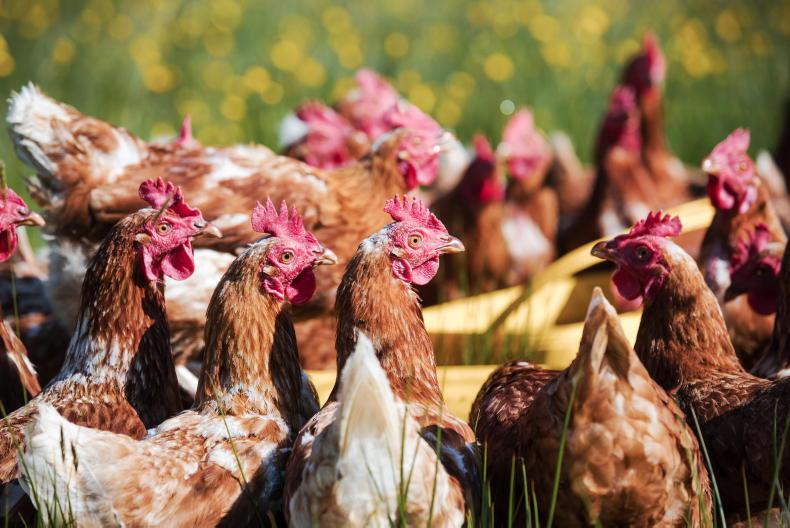
The assessments help to highlight the points of greatest risk in each farm. \ Claire Nash
When looking at specific biosecurity sections on broiler units, sections such as the entrance of personnel and visitors, infrastructure and biological vectors, location of the farm, disease management and measures between houses typically score well.
Measures requiring improvement
Measures focusing on the depopulation of broilers, supply of material and cleaning and disinfection require further improvement.
Examples of these measures would be ensuring that transport vehicles taking poultry to the slaughterhouse are always empty on arrival at the farm, not allowing entrance of transport staff into the poultry houses, and disinfecting material before entering the farm.
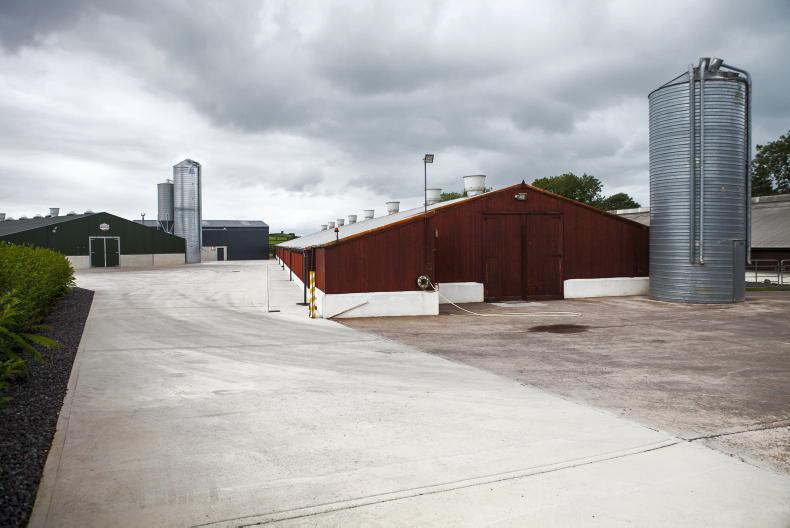
Cleaning and disinfection of yard areas is an important part of a biosecurity plan on a poultry farm. \ Philip Doyle
In terms of internal biosecurity, installing a farm hygiene lock helps prevent the dissemination of disease within a farm.
For layer units, sections such as purchase of one-day-old chicks, purchase of layers, feed and water supply, removal of manure and dead animals, infrastructure and biological vectors, disease management and cleaning and disinfection score well for most of the layer units assessed so far.
Measures focusing on the transport of eggs, supply of materials and entrance of personnel and visitors require further improvement.
These could include not allowing the driver of vehicles transporting eggs to have access to the egg facilities on farm, ensuring that such vehicles are empty on arrival at the farm, disinfecting material before entering the farm, and installing a farm hygiene lock.
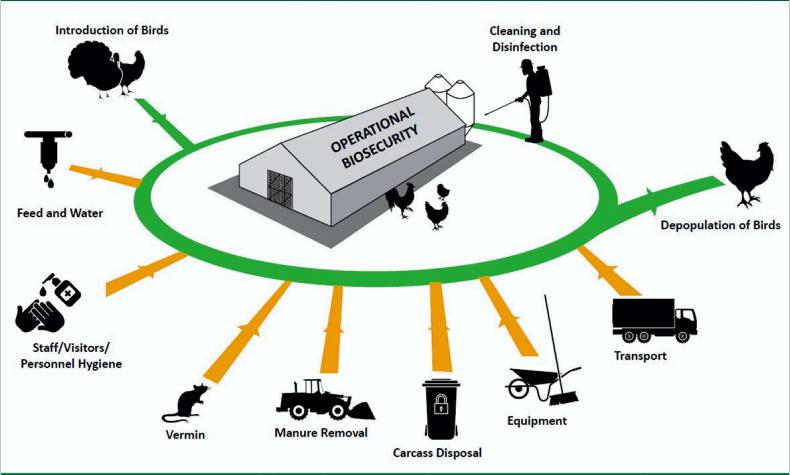
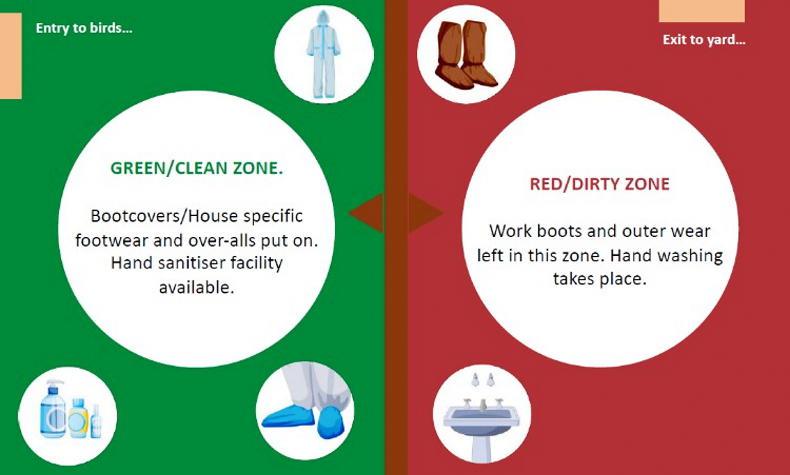
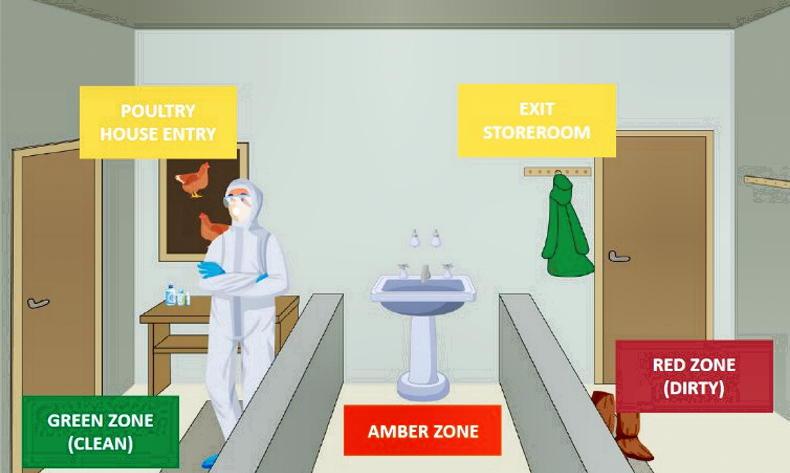
Three hundred and three broiler units and 41 layers units have been assessed more than once. In both, a slight improvement was observed for external biosecurity, while the same was not observed for internal biosecurity.
External biosecurity
Purchase of one-day-old chicks.Purchase of laying hens.Depopulation of the poultry houses.Feed and water.Transport of eggs.
Removal of manure and carcases.Visitors and farm workers.Material supply.Infrastructure and biological vectors.Location of the farm.Internal biosecurity
Disease management.Cleaning and disinfection.Materials and measures between compartments.
The poultry industry faces ongoing challenges in preventing introduction and spread of infectious diseases (especially avian influenza).
Biosecurity refers to practices designed to reduce the risk of introduction and spread of disease agents.
It can be subdivided into two components: external biosecurity (bioexclusion) which is aimed at keeping pathogens out of the unit; and internal biosecurity (biocontainment) which focuses on preventing their spread within the unit.
Implementing biosecurity measures has also been shown to have other benefits, including improved productivity, profitability and reduced antimicrobial usage.
A recent Irish study showed that broiler units with high biosecurity scores had fewer flocks positive to Campylobacter compared to units with lower biosecurity.
One of the best ways to understand and improve the biosecurity status of units is through regular independent assessment by a trained private veterinary practitioner (PVP).
A standardised assessment (using the BiocheckUGent system) is available across the Irish poultry industry. These are fully funded through the Targeted Advisory Service on Animal Health (TASAH) under the Rural Development Programme.
The programme is overseen by Animal Health Ireland, with payment being made directly to the PVP, following completion of the assessment.
Only PVPs who have been trained in these assessments are funded for their delivery. A list of trained PVPs is available here.
Flock owners can directly contact one of these trained PVPs to request this service, which is available annually to broiler, layer, turkey and breeder units.
The assessments include several sections for external and internal biosecurity, which assess and score risks related with live animals, animals’ products, carcase management, operations (eg transport of suppliers, animal transport, waste/water management, facility hygiene, cleaning and disinfection protocols), personnel flows (eg visitor policy, farm staff, management of work routines), facilities (eg fences and entrances), and immunity management (eg vaccination protocols).
Each section is scored from 0% (poor) to 100% (optimal) and weighted, according to their importance in terms of risk for introduction and spread of infection.
The assessments help to highlight the points of greatest risk in each farm, providing the opportunity for the flock owner and PVP to agree up to three prioritised, achievable measures to improve biosecurity.
A detailed report, including the scores for section, benchmarking those against the national average and the agreed management changes generated for PVPs to provide to the flock owners. Repeating the assessment each year allows improvements over time to be demonstrated.
At the end of October 2023, biosecurity on 397 broiler units and 123 for layer units had been assessed at least once, representing around 100% and 63% of all commercial broiler units and layer units.
Overall, for broiler and layer flocks, internal biosecurity scores better than external biosecurity (Figure 1).
Direct comparison of the scores between broiler and layer units is hampered by the low coverage of layer units assessed so far.

The assessments help to highlight the points of greatest risk in each farm. \ Claire Nash
When looking at specific biosecurity sections on broiler units, sections such as the entrance of personnel and visitors, infrastructure and biological vectors, location of the farm, disease management and measures between houses typically score well.
Measures requiring improvement
Measures focusing on the depopulation of broilers, supply of material and cleaning and disinfection require further improvement.
Examples of these measures would be ensuring that transport vehicles taking poultry to the slaughterhouse are always empty on arrival at the farm, not allowing entrance of transport staff into the poultry houses, and disinfecting material before entering the farm.

Cleaning and disinfection of yard areas is an important part of a biosecurity plan on a poultry farm. \ Philip Doyle
In terms of internal biosecurity, installing a farm hygiene lock helps prevent the dissemination of disease within a farm.
For layer units, sections such as purchase of one-day-old chicks, purchase of layers, feed and water supply, removal of manure and dead animals, infrastructure and biological vectors, disease management and cleaning and disinfection score well for most of the layer units assessed so far.
Measures focusing on the transport of eggs, supply of materials and entrance of personnel and visitors require further improvement.
These could include not allowing the driver of vehicles transporting eggs to have access to the egg facilities on farm, ensuring that such vehicles are empty on arrival at the farm, disinfecting material before entering the farm, and installing a farm hygiene lock.



Three hundred and three broiler units and 41 layers units have been assessed more than once. In both, a slight improvement was observed for external biosecurity, while the same was not observed for internal biosecurity.
External biosecurity
Purchase of one-day-old chicks.Purchase of laying hens.Depopulation of the poultry houses.Feed and water.Transport of eggs.
Removal of manure and carcases.Visitors and farm workers.Material supply.Infrastructure and biological vectors.Location of the farm.Internal biosecurity
Disease management.Cleaning and disinfection.Materials and measures between compartments.











 This is a subscriber-only article
This is a subscriber-only article











SHARING OPTIONS: